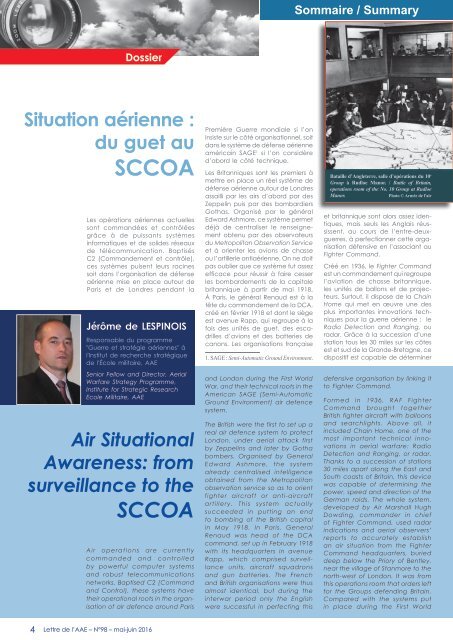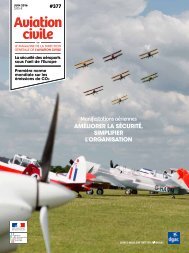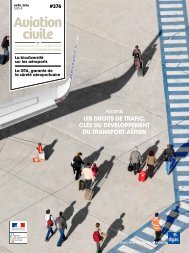La Lettre
29a5KnP
29a5KnP
Create successful ePaper yourself
Turn your PDF publications into a flip-book with our unique Google optimized e-Paper software.
Dossier<br />
Situation aérienne :<br />
du guet au<br />
SCCOA<br />
Les opérations aériennes actuelles<br />
sont commandées et contrôlées<br />
grâce à de puissants systèmes<br />
informatiques et de solides réseaux<br />
de télécommunication. Baptisés<br />
C2 (Commandement et contrôle),<br />
ces systèmes puisent leurs racines<br />
soit dans l’organisation de défense<br />
aérienne mise en place autour de<br />
Paris et de Londres pendant la<br />
Jérôme de LESPINOIS<br />
Responsable du programme<br />
"Guerre et stratégie aériennes" à<br />
l'Institut de recherche stratégique<br />
de l'École militaire, AAE<br />
Senior Fellow and Director, Aerial<br />
Warfare Strategy Programme,<br />
Institute for Strategic Research<br />
Ecole Militaire, AAE<br />
Air Situational<br />
Awareness: from<br />
surveillance to the<br />
SCCOA<br />
Air operations are currently<br />
commanded and controlled<br />
by powerful computer systems<br />
and robust telecommunications<br />
networks. Baptised C2 (Command<br />
and Control), these systems have<br />
their operational roots in the organisation<br />
of air defence around Paris<br />
Première Guerre mondiale si l’on<br />
insiste sur le côté organisationnel, soit<br />
dans le système de défense aérienne<br />
américain SAGE 1 si l’on considère<br />
d’abord le côté technique.<br />
Les Britanniques sont les premiers à<br />
mettre en place un réel système de<br />
défense aérienne autour de Londres<br />
assailli par les airs d’abord par des<br />
Zeppelin puis par des bombardiers<br />
Gothas. Organisé par le général<br />
Edward Ashmore, ce système permet<br />
déjà de centraliser le renseignement<br />
obtenu par des observateurs<br />
du Metropolitan Observation Service<br />
et à orienter les avions de chasse<br />
ou l’artillerie antiaérienne. On ne doit<br />
pas oublier que ce système fut assez<br />
efficace pour réussir à faire cesser<br />
les bombardements de la capitale<br />
britannique à partir de mai 1918.<br />
À Paris, le général Renaud est à la<br />
tête du commandement de la DCA,<br />
créé en février 1918 et dont le siège<br />
est avenue Rapp, qui regroupe à la<br />
fois des unités de guet, des escadrilles<br />
d’avions et des batteries de<br />
canons. Les organisations française<br />
1. SAGE : Semi-Automatic Ground Environment.<br />
and London during the First World<br />
War, and their technical roots in the<br />
American SAGE (Semi-Automatic<br />
Ground Environment) air defence<br />
system.<br />
The British were the first to set up a<br />
real air defence system to protect<br />
London, under aerial attack first<br />
by Zeppelins and later by Gotha<br />
bombers. Organised by General<br />
Edward Ashmore, the system<br />
already centralised intelligence<br />
obtained from the Metropolitan<br />
observation service so as to orient<br />
fighter aircraft or anti-aircraft<br />
artillery. This system actually<br />
succeeded in putting an end<br />
to bombing of the British capital<br />
in May 1918. In Paris, General<br />
Renaud was head of the DCA<br />
command, set up in February 1918<br />
with its headquarters in avenue<br />
Rapp, which comprised surveillance<br />
units, aircraft squadrons<br />
and gun batteries. The French<br />
and British organisations were thus<br />
almost identical, but during the<br />
interwar period only the English<br />
were successful in perfecting this<br />
Bataille d’Angleterre, salle d’opérations du 10 e<br />
Group à Rudloe Manor. / Battle of Britain,<br />
operations room of the No. 10 Group at Rudloe<br />
Manor.<br />
Photo © Armée de l'air<br />
et britannique sont alors assez identiques,<br />
mais seuls les Anglais réussissent,<br />
au cours de l’entre-deuxguerres,<br />
à perfectionner cette organisation<br />
défensive en l’associant au<br />
Fighter Command.<br />
Créé en 1936, le Fighter Command<br />
est un commandement qui regroupe<br />
l’aviation de chasse britannique,<br />
les unités de ballons et de projecteurs.<br />
Surtout, il dispose de la Chain<br />
Home qui met en œuvre une des<br />
plus importantes innovations techniques<br />
pour la guerre aérienne : le<br />
Radio Detection and Ranging, ou<br />
radar. Grâce à la succession d’une<br />
station tous les 30 miles sur les côtes<br />
est et sud de la Grande-Bretagne, ce<br />
dispositif est capable de déterminer<br />
defensive organisation by linking it<br />
to Fighter Command.<br />
Formed in 1936, RAF Fighter<br />
Command brought together<br />
British fighter aircraft with balloons<br />
and searchlights. Above all, it<br />
included Chain Home, one of the<br />
most important technical innovations<br />
in aerial warfare: Radio<br />
Detection and Ranging, or radar.<br />
Thanks to a succession of stations<br />
30 miles apart along the East and<br />
South coasts of Britain, this device<br />
was capable of determining the<br />
power, speed and direction of the<br />
German raids. The whole system,<br />
developed by Air Marshall Hugh<br />
Dowding, commander in chief<br />
of Fighter Command, used radar<br />
indications and aerial observers’<br />
reports to accurately establish<br />
an air situation from the Fighter<br />
Command headquarters, buried<br />
deep below the Priory of Bentley,<br />
near the village of Stanmore to the<br />
north-west of London. It was from<br />
this operations room that orders left<br />
for the Groups defending Britain.<br />
Compared with the systems put<br />
in place during the First World<br />
4 <strong>Lettre</strong> de l’AAE – N°98 – mai-juin 2016





